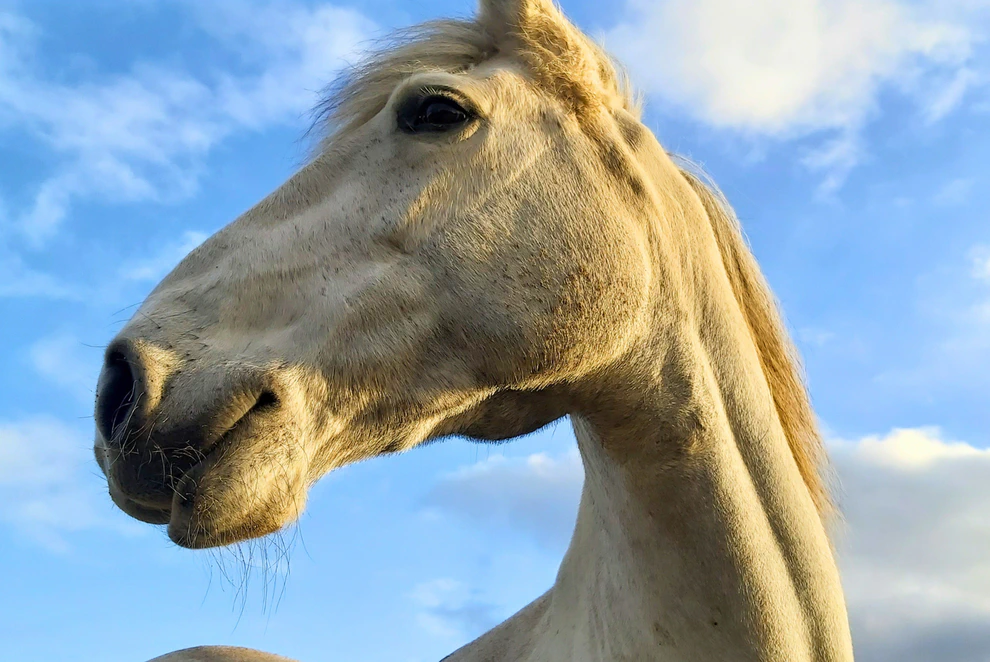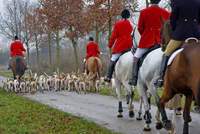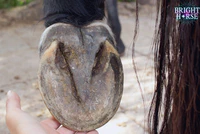Listen to the Blog-Cast:
Understanding How Horses Learn
Horses are intelligent, emotional, highly compliant and perceptive animals, but their learning processes honed through domestication, differ significantly from our own. Understanindg the fundamentals of how horses learn lays an important the groundwork for effective and humane training techniques.
I’ll be quite honest, this isn’t new, alot of it your are applying already. However (big however) the language we use and conclustion we make about what a horse is doing (their behaviour) is often in correct. when we fail to understand the science of horse behaviour, trainng and learning we run the risk of failing to achieve our goals, impact our horses welfare and incorrectly attribute human ideas on to our horses (which don’t exsist)
This Blog (and accompanying BlogCast, click above) hopes to help you navigate the science behind horse training, making it accessible and actionable. I hope to leave you with greater understanding of the principles that guide your horse’s learning journey, tools to address behavioural challenges, and insights into fostering a stronger bond with your horse.
What is Learning Theory
First and foremost, we call it a ’theory’ because of some old principles in science. It’s about math, stay with me! Math is one of the only sciences that can have a ‘proof.’ The term proof comes from mathematics. This is where every equation proves itself—it sounds more complicated than it is.
So, 2+2=4.To prove that, we unbake the cake and say 4/2=2.We can also say 4-2=2.Finally, 2x2=4.
This is a ‘proof,’ in that we were able to prove that 2+2 does indeed equal 4.
However, in biology we can’t unbake the cake. Once we teach an animal something—behaviour is a biological function—we can’t unlearn it and create a proof. Stick with my cake example, as biology is also cake! I can have all the correct ingredients: flour, butter/oil, eggs, chocolate, baking powder. I can have all the instructions, time, and temperature to cook at.
The issue is, my oven is different than yours, ever so slightly (called noise or variation). You might read the instructions differently, or I might not mix the ingredients quite right. We both end up with a ‘cake.’ Mine might be less serviceable than yours, but a cake we have. We can’t unbake it to see what went into it. The only way we can know if it is truly a cake is to replicate it.
Same oven, same ingredients, same instructions over and over and over again. Until the volume of cakes we can now see makes it undeniably, a cake.
And thus, as it was said and so it shall be… Cake Theory was born.
Joking aside, that is why it’s called a theory. We can’t prove it from a mathematical sense, but nothing in biology can really be done that way (unless it’s maths). The rest is years and years of study, repetition, and research. Just because it says theory, doens’t make it fiction.
That being said, ‘Learning Theory’ is a scientific framework that explains how organisms (all animals), including horses, acquire, process, and apply knowledge. It forms the foundation of Equitation Science, animal behaviour, and psychology—a discipline that integrates scientific research with horse training to enhance welfare and performance.
Why Learning Theory Matters
Understanding learning theory isn’t just an academic exercise—and if you followed my convoluted cake example, this part will feel simple! Learning theory has real, everyday importance in how we train and care for horses. Horses don’t think or learn like humans, at least not in the same way, and when we misinterpret their behaviour through a human lens, we risk confusion, frustration, or even harming their welfare.
By applying learning theory, we can:
- Communicate with horses in a way they clearly understand.
- Avoid outdated or harsh methods that rely on fear or misunderstanding.
- Build trust and cooperation through predictable, fair training.
- Improve both safety and performance by reducing stress and conflict.
When we train with the principles of learning theory in mind, we aren’t just teaching skills, we’re creating a shared language between human and horse. This foundation makes training more effective, humane, and enjoyable for both partners.
The Science of How Horses Learn
Horses process information in straightforward and predictable ways, allowing trainers to establish clear communication pathways if we use it correctly.
- Non-associative learning involves changes in behaviour based on repeated exposure to a stimulus.
Habituation:
The horse learns to ignore a stimulus that has no consequences. For example, a horse grazing near a road may become desensitised to traffic sounds over time.
Sensitization:
The horse’s response intensifies with repeated exposure to a stimulus, especially when that stimulus is perceived as threatening. For instance, a horse may become more reactive to an unfamiliar sound if it is presented abruptly or repeatedly in a stressful context.
- Associative learning involves forming connections between events. We as humans do this all the time, think about when we see ‘dark grey clouds’ we have learnt that that means rain or bad weather is on the way. We have created an association between ‘dark grey clouds’ and ‘rain’.
Classical Conditioning:
The horse learns to associate a previously neutral stimulus with a meaningful one. For instance, a horse may associate the sound of a feed bucket with the arrival of food. In training, this process enables cues like voice commands or rein signals to elicit desired behaviours.
Operant Conditioning:
This involves learning through the consequences of behaviour. Horses adapt their actions to maximise rewards or minimise discomfort. Operant conditioning is key for teaching new skills and managing behaviour.
Operant conditioning is one of the most commonly used learning theories in horse training. However, it can be tricky to fully grasp due to the terminology, which originates from psychological concepts established at the time the theory was formalised. To make matters more confusing, shorthand terms like +R (positive reinforcement) or the occasionally inaccurate R+ are often used, though the correct abbreviation is actually VE+R. These terms can vary depending on whether the trainer is from Europe, the U.S., or has a different background, adding another layer of complexity. Unfortunately, this inconsistency can make the subject unnecessarily confusing for everyone involved.
This is often why we refer to it as ‘pressure release’ or ‘clicker training’, as folks tend to understand that better. But I do think it is important to understand the concepts.
The key points to remember are straightforward. Reinforcement strengthens a behaviour (think of reinforcing a bridge to make it sturdier), while punishment is designed to reduce the likelihood of a behaviour (similar to sending someone to prison for committing a crime).
The “plus” and “minus” symbols in operant conditioning indicate whether something is being added or removed. For example, prison involves the addition of confinement (positive punishment for a behaviour), just as adding metal beams reinforces a bridge (adding beams is postive reinforcement). Conversely, negative punishment involves removing something desirable to decrease a behaviour—for instance, if a child knocks their dinner to the ground, their dinner is taken away to discourage the behaviour.
It’s important to think of this in mathematical terms, she’s back talking about math…: adding or removing something based on behaviour. There’s often debate about which method is “better,” but it’s not about good or bad—these concepts simply are. They’re like oxygen in the air, a fundamental part of how learning happens. Moreover, we can’t only use one quadrant of operant conditioning; they’re interconnected.
For example, imagine I’m rewarding my horse with food (positive reinforcement) for standing still while I handle their feet. If the horse moves away and pulls their leg back, this breaks contact with me hand and negative reinforcement. These processes often occur simultaneously, sometimes without us even realising it. They’re neither inherently good nor bad; they’re just how horses learn, whether we intend them to or not.
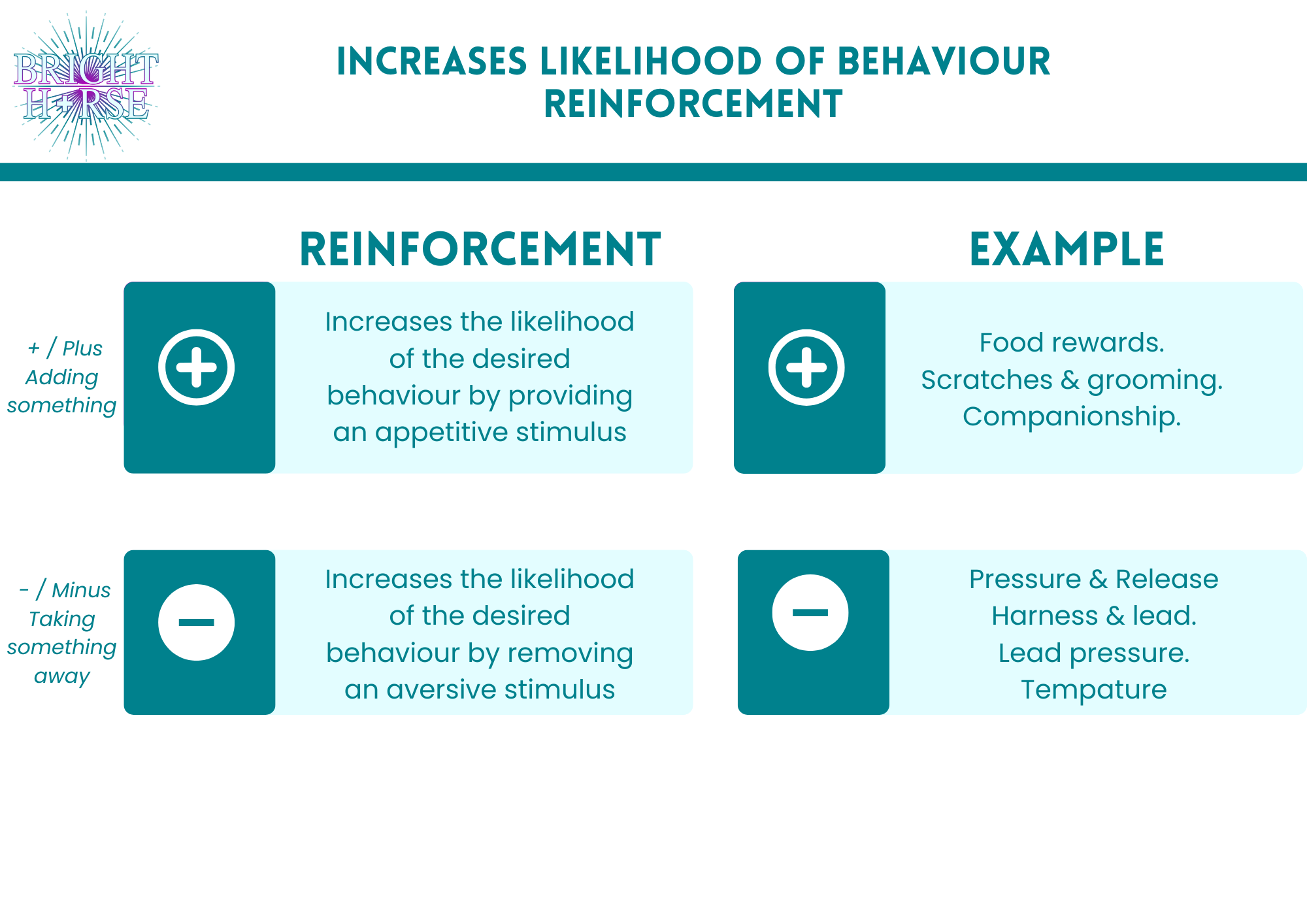
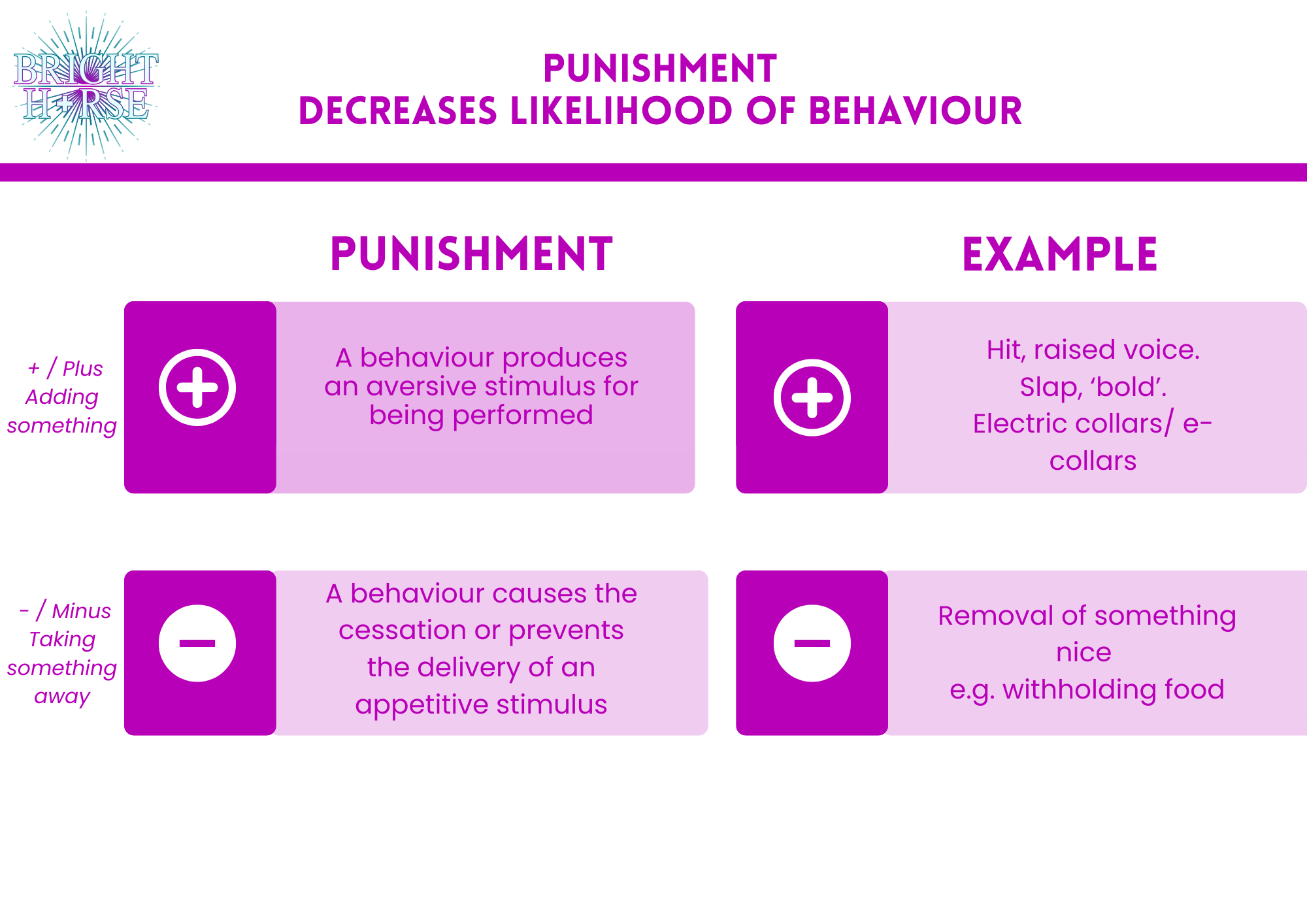
The Role of Timing and Consistency
For training to work well and stay kind to the horse learning, timing and consistency are absolutely critical. Horses do best when they can rely on cues being predictable, and when reinforcements happen right away. If the timing is off or cues aren’t consistent, it can lead to confusion, frustration, and even unwanted behaviours. Understanding what we are doing when we are doing it is important.
Horses need to figure out how to apply learned behaviours in different situations (generalisation) and how to tell the difference between similar cues (discrimination). For example, they might learn to stand still in both a quiet on the yard and a busy competition, but also need to recognise distinct signals for “stop” versus “slow down.” Shaping is key, this involves teaching complex behaviours by breaking them down into smaller steps. You reward small improvements as the horse gets closer to the final behaviour, gradually building toward the desired outcome.
Finally we want to ensure that we have ‘Stimulus Control’ this means ensuring the horse responds reliably to a specific cue. Achieving this requires clear signals, consistent use, and the right reinforcement at the right time. In order to get a behaviour on stimulus control we need to have good time, be consistent and be clear in our learning theory.
The Importance of Equitation Science
Equitation Science bridges learning theory with horse ethology, the study of natural behaviours, to refine training methods. By aligning training practices with scientific insights, Equitation Science prioritises are what we, I think as horse riders and owners, all really want; clear communication with our horses. We want to establishing a common language between horse and rider, achieve our goals and enjoy our horses. We want to enhance welfare and reduce stress, as well as promoting mental and physical well-being. And or course we want to optimised our riding/training, so we can achieve results efficiently while preserving the horse’s self.
Training is not without its challenges. Horses are prey animals with instincts that can complicate learning, such as bolting in response to fear. Additionally, one-trial learning (which is just want it sounds like… which is so hard for us…), where a horse forms strong associations from a single negative experience, underscores the need for careful and humane methods.
We must also guard against anthropomorphism, this is attributing human emotions or reasoning to horses. Because it can lead to misunderstandings and inappropriate training practices.

